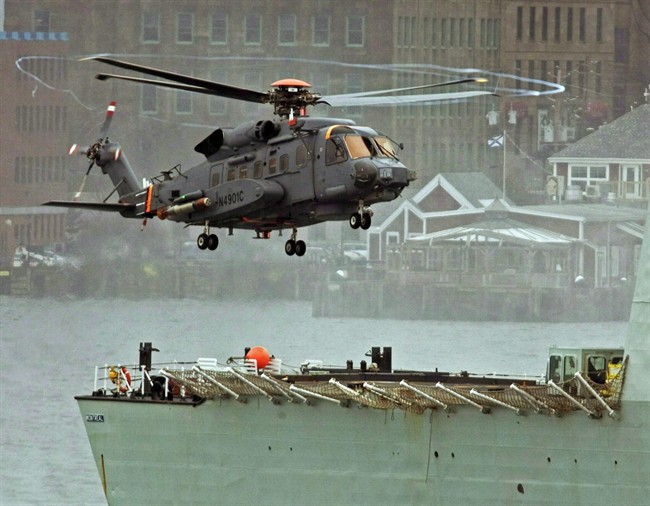Testing of some of Canada’s new navy helicopters has hit a snag.

The Canadian Forces says a sonar system used by some CH-148 Cyclones must be removed before the helicopters are allowed to land on ships.
The military said in an email that the sonars risk being bumped by a landing system that tethers the helicopter to the ship.
READ MORE: Cyclone helicopters grounded after landing incident in Nova Scotia
The sonar system, which is typically lowered into the water for use, protrudes slightly from the bottom of the helicopter after it has been reeled into the fuselage.
“The protrusion from the base of the helicopter introduces a risk of the sonar striking the C-RAST (landing system) during a ship landing,” wrote Maj. Holly-Anne Brown. “Due to this interference, the … aircraft is not cleared to conduct embarked operations with the sonar installed.”
The group of 14 helicopters, known as “Block 1” Cyclones, can still conduct operations from land, and can be used for testing and training after maintenance personnel have removed the sonars.

Get breaking National news
As well, Brown said the Sikorsky-designed helicopters have other systems for anti-submarine warfare.
The previous Liberal government originally signed a contract with U.S. defence giant Sikorsky to deliver 28 CH-148 Cyclone helicopters by 2008. The program has faced delays and technical challenges, resulting in two contract extensions.
Brown said the U.S.-based manufacturer will be redesigning the sonar system to avoid the problem in the remaining 14 helicopters.
“There is an engineering design change implemented on the … aircraft which will result in approval for sonar installation during embarked operations,” she wrote.
The next batch of Cyclones is scheduled for delivery in February 2018.
WATCH: “Milestone” reached as government gets 4 new Cyclones
Brown said the Helicopter Long-Range Active Sonar, or HELRAS, made by L3 Ocean Systems is an “additional system” that can be used to detect sub-surface targets, but it is not the only means of carrying out anti-submarine operations.
She said all of the other sensor systems on the CH-148, including radar, can still be used in training and testing.
The officer said nobody was available to discuss questions about the cost of the changes to the helicopter fleet.
She also confirmed that the Sikorsky CH-124 Sea King helicopter squadron based in Halifax will formally come under the authority of 443 Squadron in Patricia Bay, B.C., in January.
The Sea Kings, in service since 1963, will continue to operate on Canadian warships until December of next year, as testing and training on the Cyclones continues.
Earlier this year, a senior military official said the plan was to begin receiving six completed Cyclones by June 2018 and approximately one helicopter per month after that as the Sea Kings wrap up their duties.
Delays in delivery of the Cyclone helicopter are a sensitive issue, as it is years behind its original projected delivery date and the Sea Kings have some limits on the kinds of missions they can carry out due to their age.








Comments